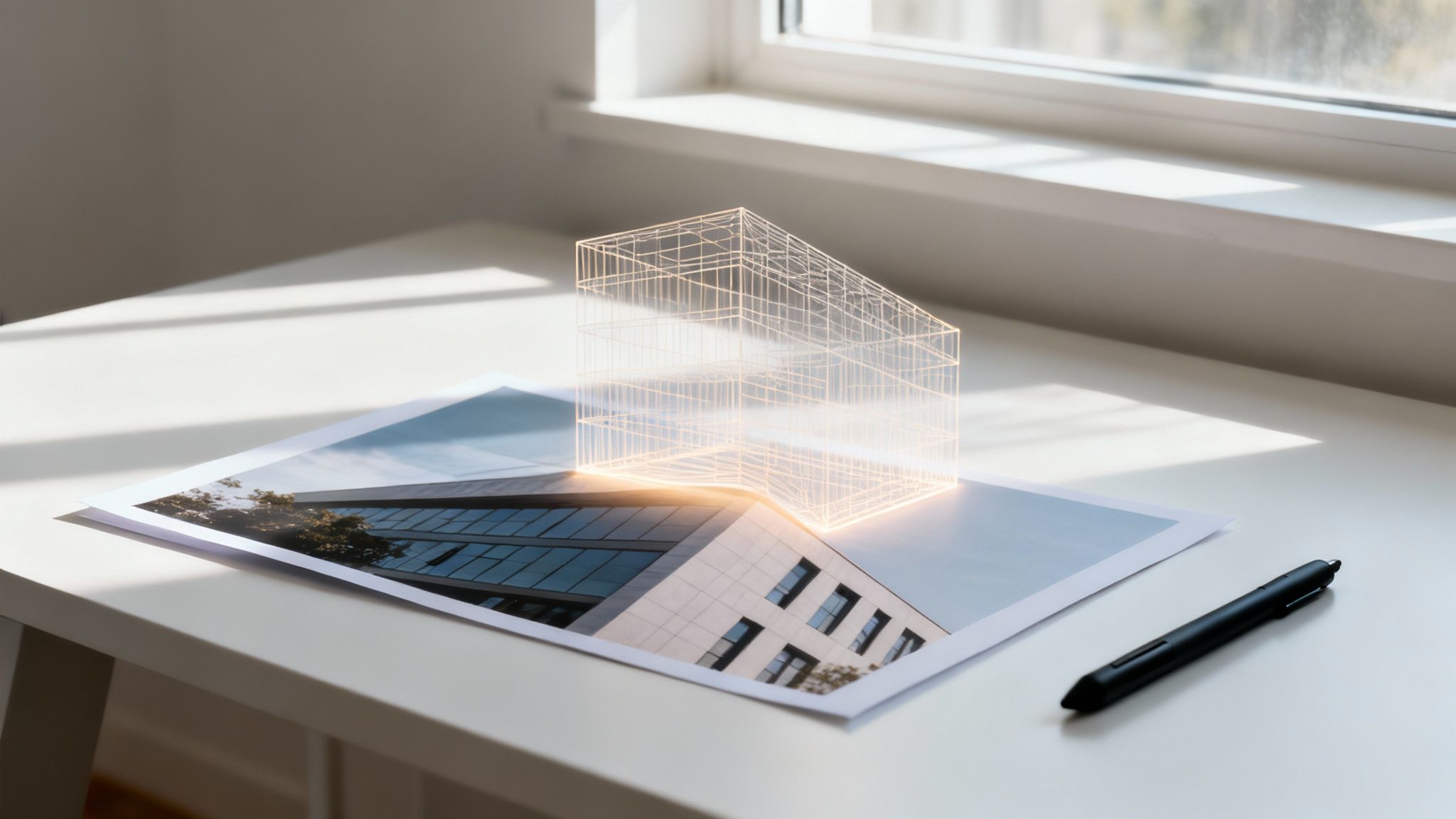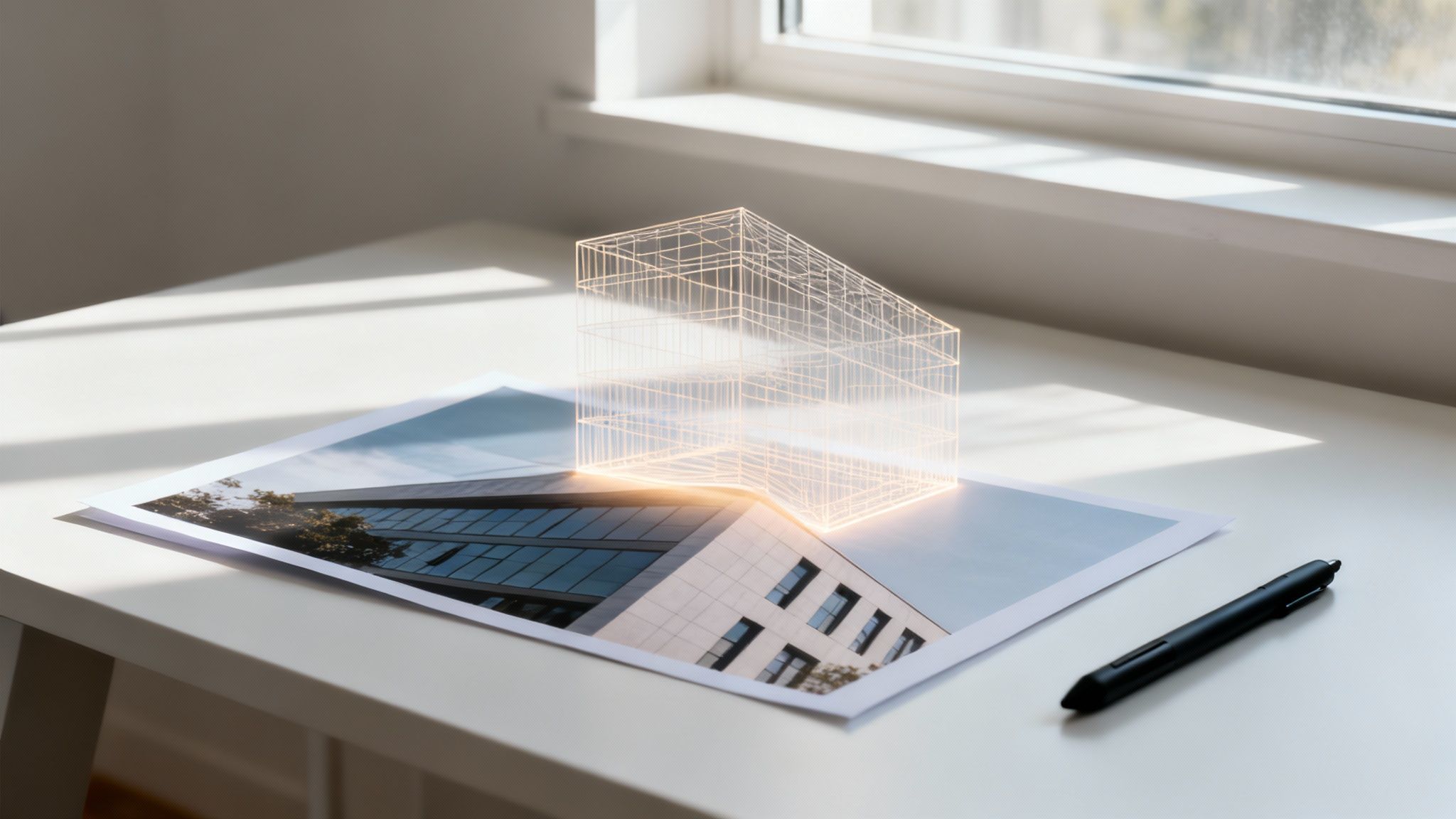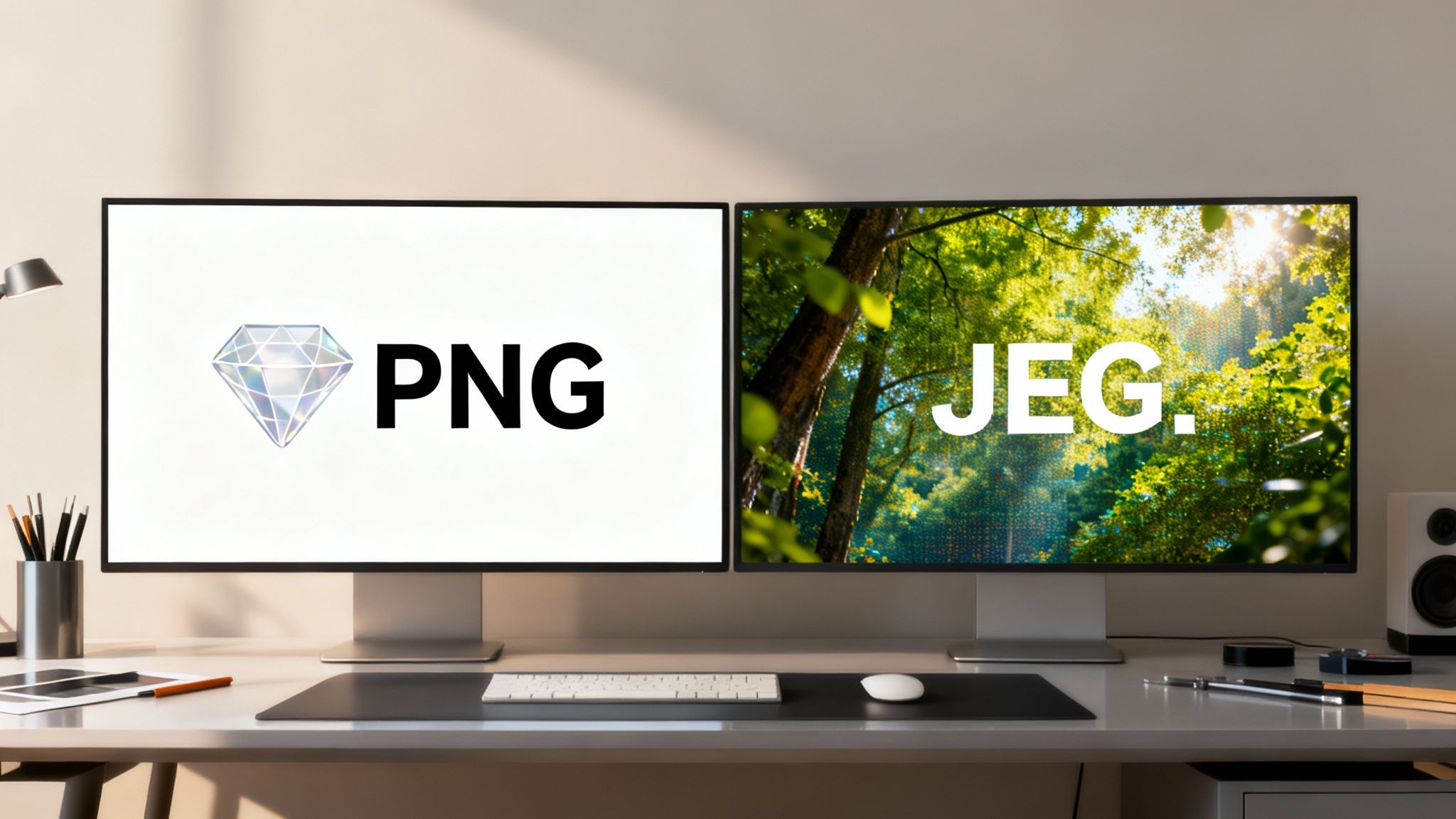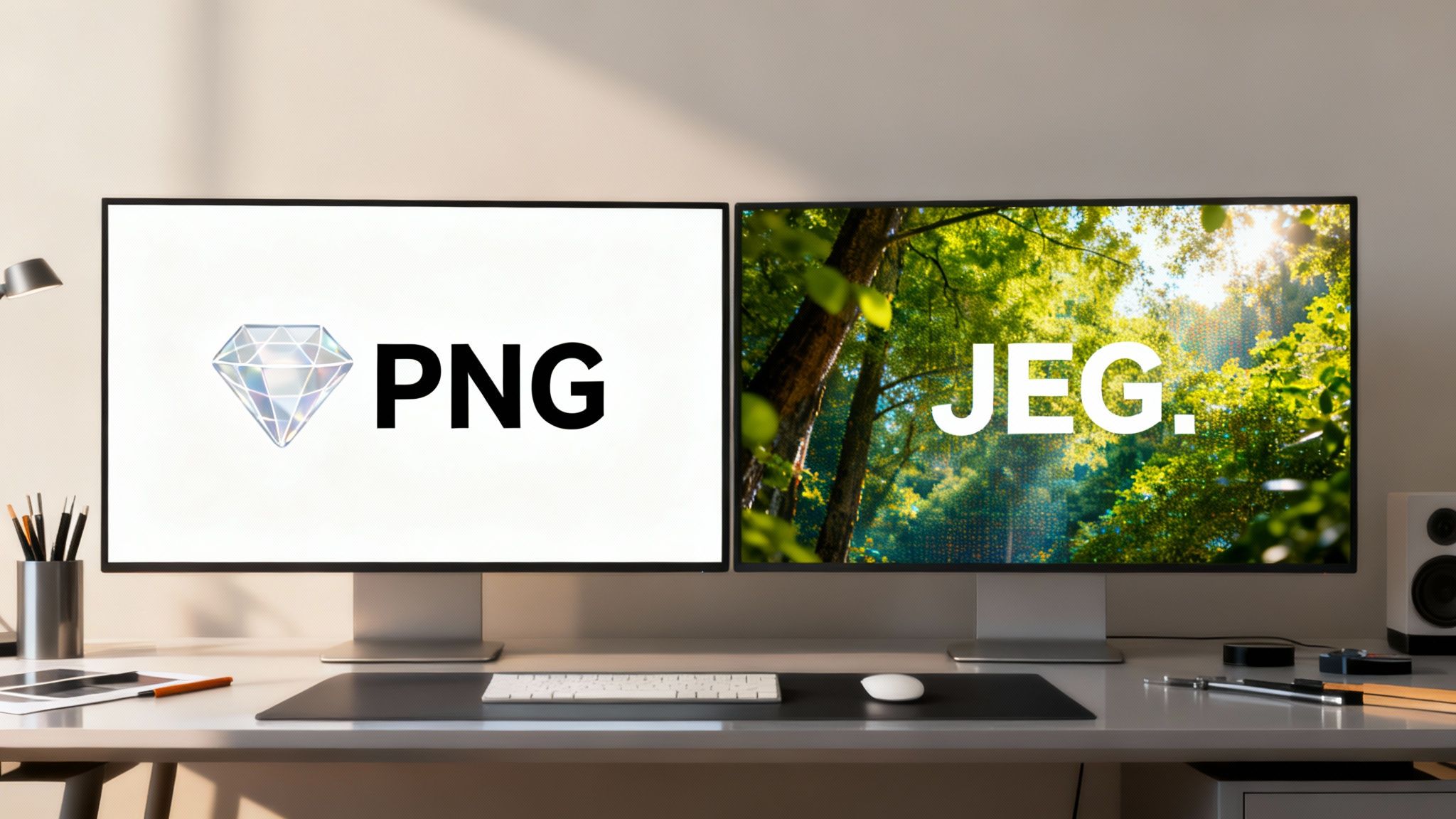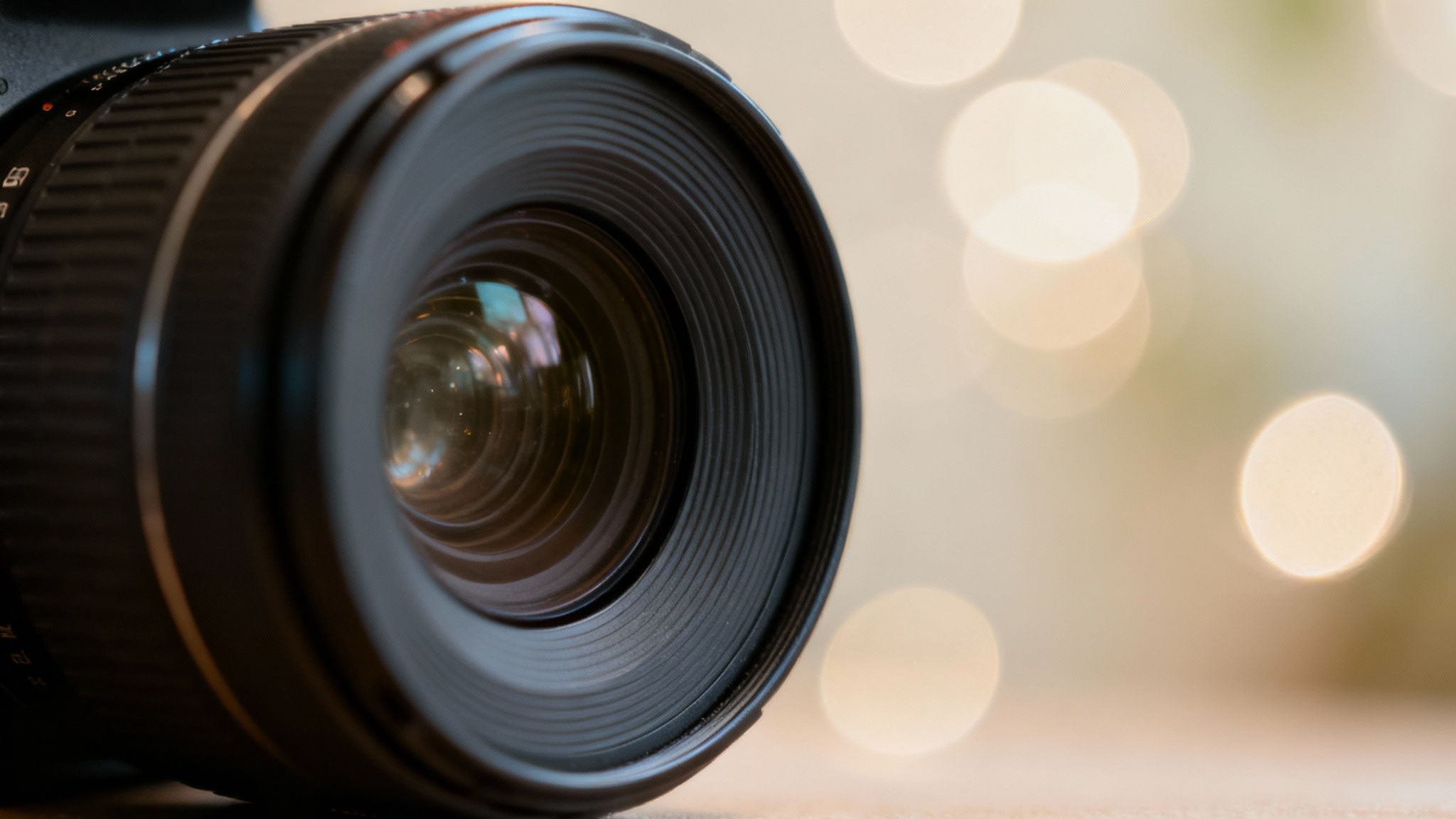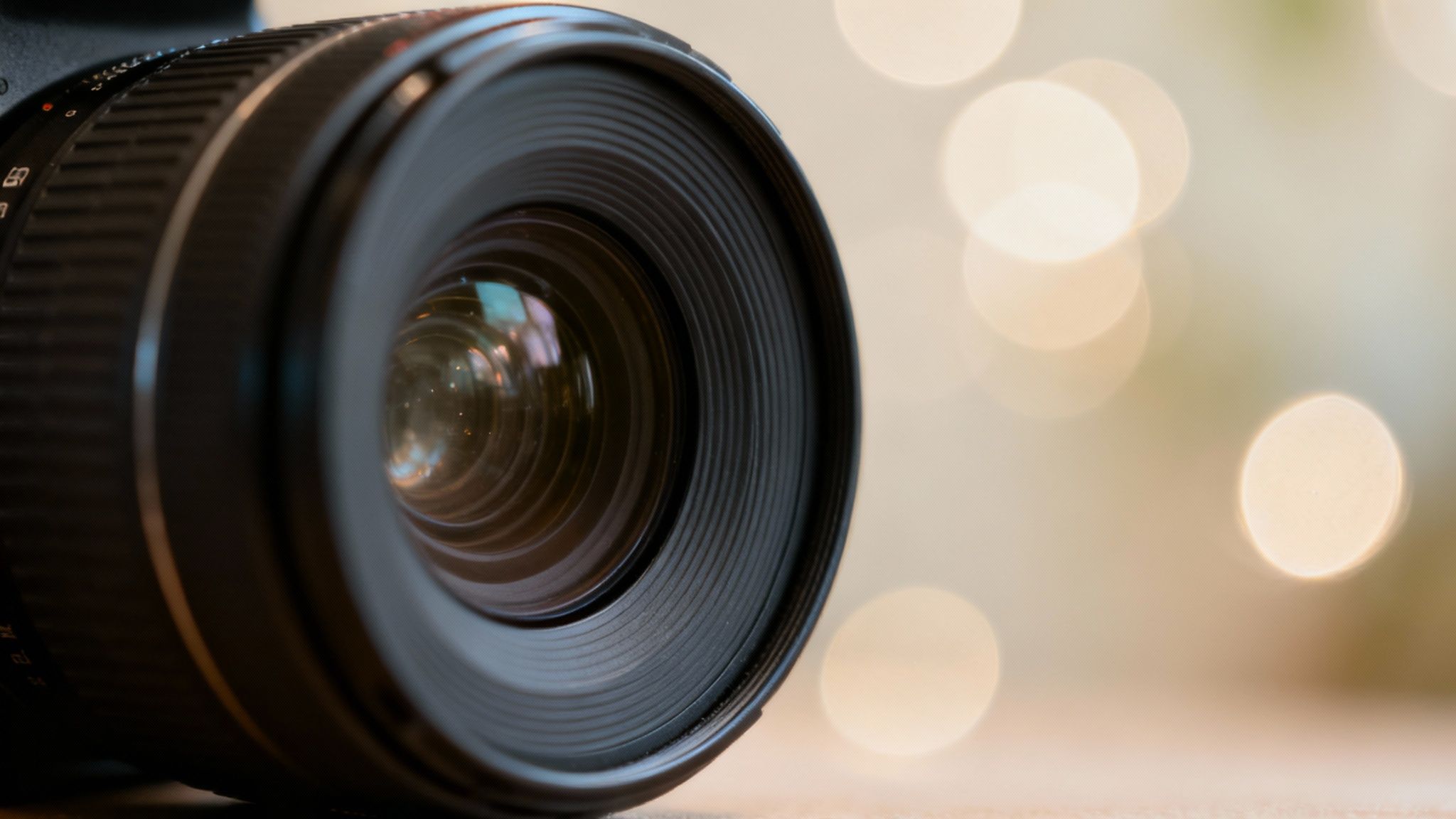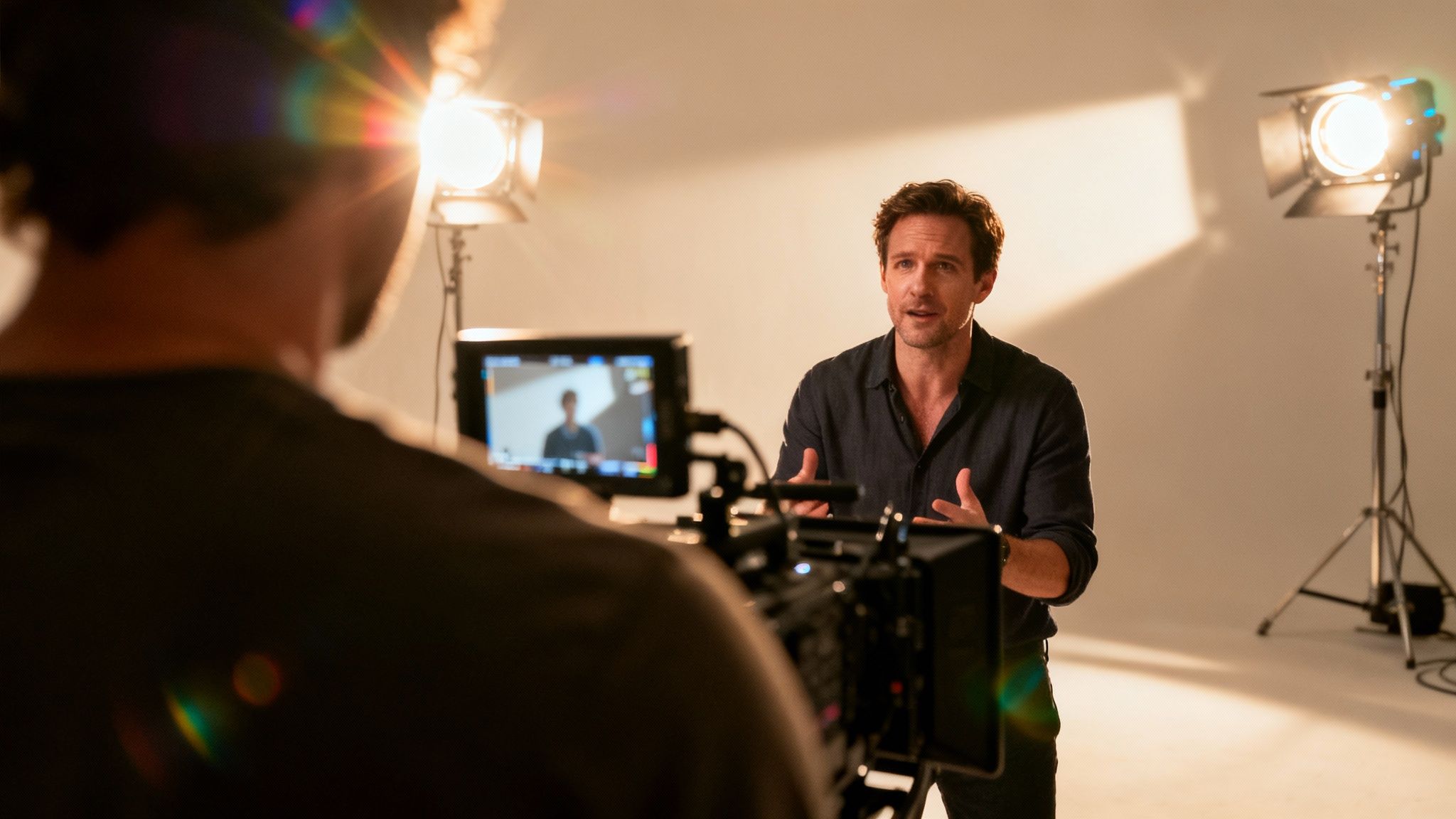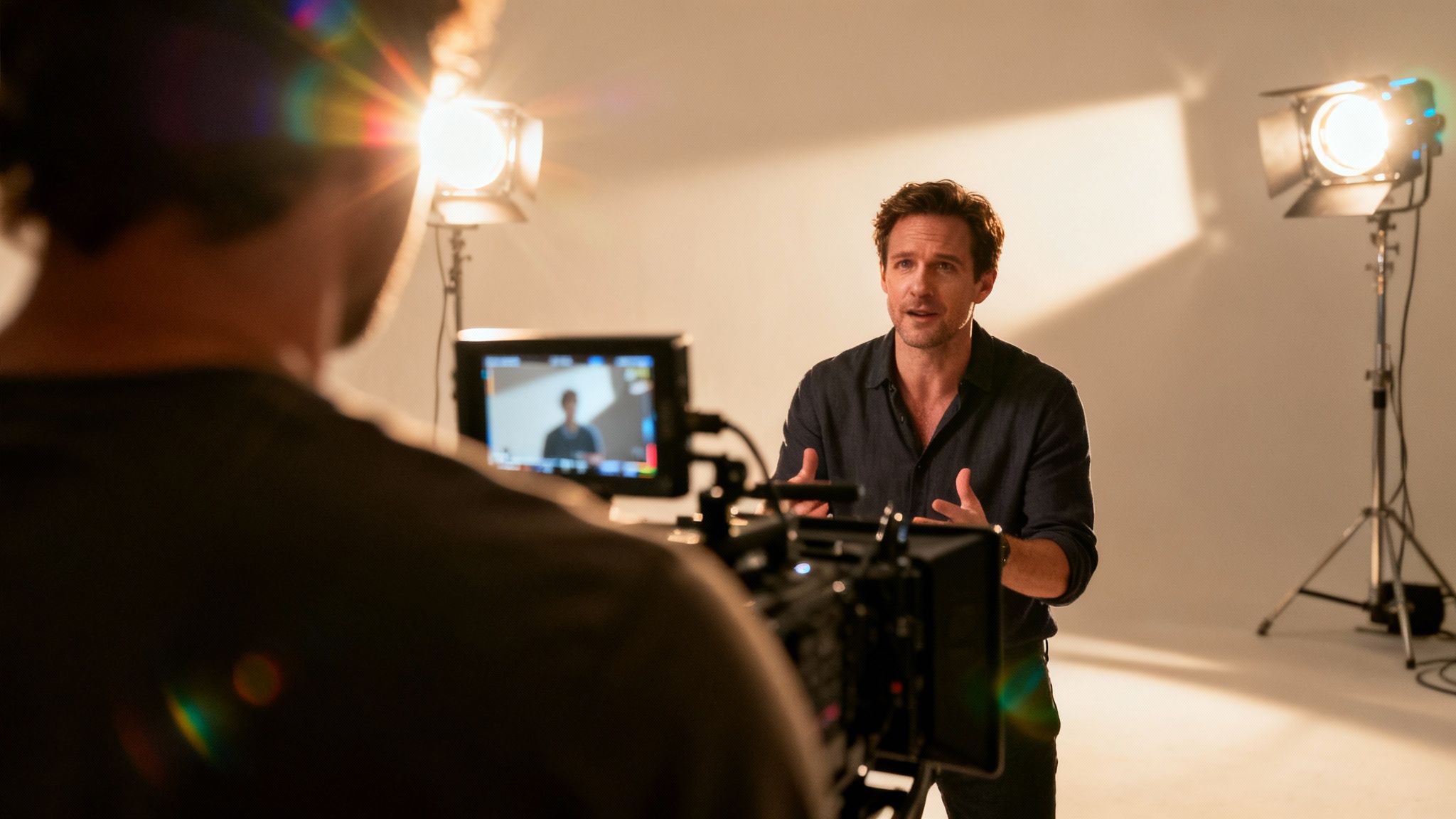Have you ever considered how to transform a standard 2D image into a functional 3D model? This process is no longer a futuristic concept. AI-powered platforms can now analyze an image's shape, depth, and texture to generate a three-dimensional asset. This represents a significant evolution from traditional, time-consuming manual modeling, enabling creative professionals to develop prototypes and build assets from a single photograph with greater efficiency and control.
From Flat Image to Immersive 3D Model
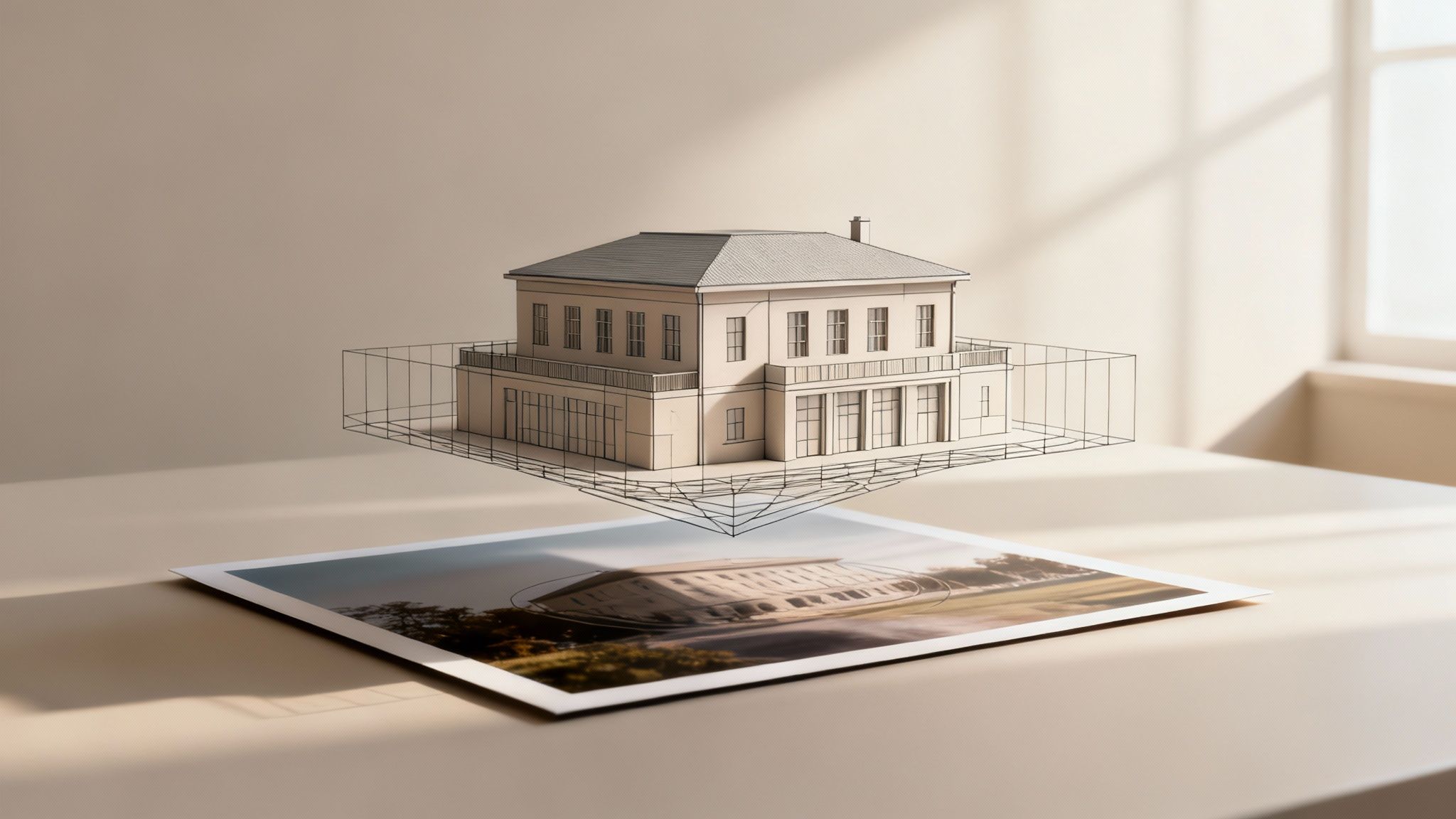
Welcome to a new frontier in digital creation, where a simple photograph can become the foundation for a tangible 3D asset. This is a pivotal development for architects, game designers, and visual artists. This guide provides a professional framework for using AI tools to responsibly integrate this powerful capability into your workflow.
Instead of dedicating days or weeks to meticulously building a model from scratch, you can now generate a robust starting point in minutes. This shift allows creative professionals to concentrate on high-level refinement and artistic direction, rather than being mired in repetitive technical tasks. The core of this process involves sophisticated algorithms that analyze a 2D image, infer its volumetric and surface properties, and then construct a corresponding 3D mesh.
Why This Technology Matters for Business
The real-world applications for this technology are expanding rapidly, moving from experimental use cases to essential tools in professional workflows. For creative teams, the primary benefits are accelerated turnaround times and more streamlined production pipelines.
Here’s why this skill is becoming a critical component of modern creative work:
- Rapid Prototyping: Product designers can take a sketch or photo of a concept and have a 3D model ready for visualization, enabling faster iteration and stakeholder feedback.
- Game Development: Environment and prop artists can efficiently populate game worlds with unique assets derived from real-world photos, increasing content diversity while managing resources.
- Architectural Visualisation: Architects can convert site photos or building plans into 3D models for urban planning, environmental impact studies, and compelling client presentations.
- E-commerce and Marketing: Brands can create interactive 3D product views from standard studio photography, offering customers a more engaging and informative shopping experience.
A Growing Market for 3D Visualisation
The demand for these skills is supported by significant market growth. Denmark, for instance, has emerged as a key European hub for digital visualization. In 2024, the Danish 3D rendering market generated $53.2 million in revenue and is projected to reach $243.1 million by 2033.
This expansion is fueled by the widespread adoption of digital tools that transform flat images into immersive experiences, with software accounting for over 82% of the market's revenue. For a deeper understanding of the technologies driving this shift, it's worthwhile to explore platforms like AI tools like Luma AI. It offers a valuable perspective on the industry's trajectory.
Preparing Your Image for a Flawless 3D Conversion
The quality of your final 3D model is directly dependent on the quality of the source image provided to the AI.
Consider this analogy: an architect cannot produce a perfect blueprint from a blurry, poorly lit sketch. The same principle applies to AI. Proper preparation of the input image saves hours of post-generation cleanup and mesh correction.
Your objective is to provide the AI with the clearest possible information about the object’s shape, volume, and texture. This requires a more methodical approach than simply taking a quick photo; it's akin to setting up a professional product shoot. The AI operates on the pixel data you provide, making a clean, high-quality image a non-negotiable prerequisite for a professional result.
Setting Your Image Up for Success
Before uploading an image to a platform like Virtuall, a few preparatory steps can make a substantial difference. The focus should be on clarity and simplicity. The AI must be able to easily distinguish your subject without being confused by visual noise.
A common error is using an image that is overly complex. An artistic photo with a busy background or dramatic shadows, while aesthetically pleasing, presents a challenge for the AI. Clutter, inconsistent lighting, or multiple objects can mislead the generation process, resulting in distorted or incomplete models.
Key Takeaway: The single most impactful action for a successful 2D-to-3D conversion is using a clean, well-lit, high-resolution source image. A few minutes of preparation will save hours of corrective work in tools like Blender or Maya.
The AI's Wishlist: Essential Image Attributes
What constitutes a perfect source image? The AI analyzes every detail, so optimizing a few key attributes provides it with the best opportunity to create an accurate and detailed model.
Here is a brief checklist I follow before any generation. It is straightforward but consistently yields better results.
Image Preparation Checklist for Optimal 3D Conversion
This table outlines what the AI requires and why. Adhering to these recommendations is the most efficient way to improve your 3D outputs.
Adhering to these points means you are providing a precise blueprint, not just a random picture. This proactive approach ensures the AI has all the necessary information to accurately convert your 2D image to a 3D model, giving you a solid foundation for a high-quality, professional-grade asset from the outset.
Your Workflow for AI-Powered 3D Generation
With your perfectly prepared image ready, the next step is the generation process. This is where you leverage the AI to transform flat pixels into a tangible three-dimensional object. On a platform like Virtuall, this is designed to be an intuitive and controlled process, guiding you from image upload to your first draft model without requiring specialized 3D expertise.
Getting started is straightforward. You upload your image into the workspace, at which point the AI begins analyzing the visual data—interpreting light, shadow, and contours to infer the object's underlying geometry. Once you initiate the generation, it typically takes only a few moments for the platform to construct the initial 3D mesh based on this analysis.
However, this initial output is a starting point—a first draft. The real power lies in adjusting the generation settings to refine the final result. These parameters are the controls you use to communicate your specific requirements for the model.
Navigating Key Generation Settings
To achieve optimal results from any AI tool, it's essential to understand its adjustable parameters. By tuning a few key settings, you can achieve the ideal balance between detail, performance, and style for your project.
Here are the crucial settings to familiarize yourself with:
- Model Complexity: This setting pertains to the polygon count, which determines the level of geometric detail in your model. Higher complexity results in a smoother, more intricate surface, but it also increases the file size.
- Texture Quality: This controls the resolution of the surface map—the "skin"—that is applied to your model. Higher-quality textures capture finer details from your source photo but require more processing power.
- Stylisation: Some platforms offer stylistic filters. This feature allows you to generate models in specific artistic styles—such as photorealistic, cartoon, or sculptural—directly from your image.
This is why the pre-generation steps are so critical, as this infographic highlights.
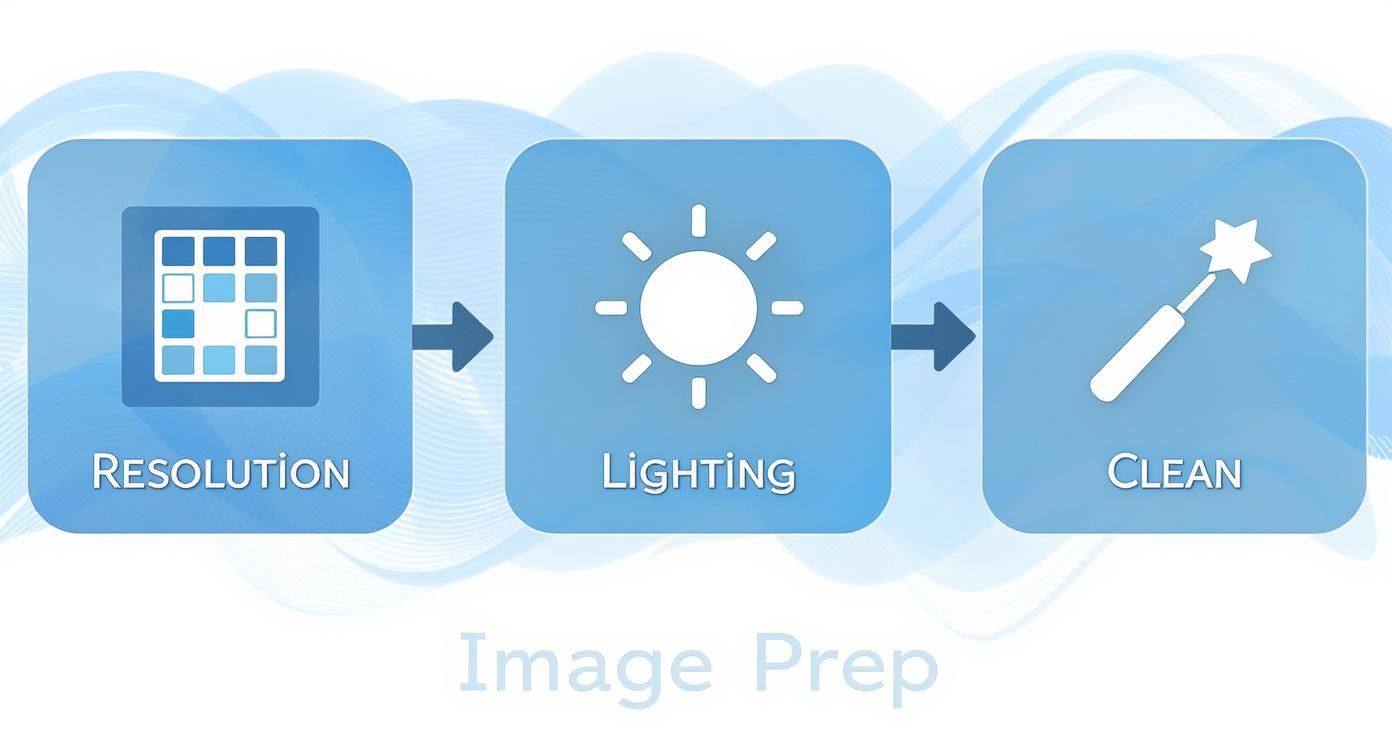
When you provide the AI with clean, high-quality data, you are setting it up for a more accurate and useful first draft.
A Practical Example: Architectural Visualisation
Let's apply this to a real-world scenario. Imagine you are an architect needing to create a 3D visualization of an existing building facade for a renovation proposal. You have a high-resolution, evenly lit photograph of the building's front.
You would upload that photo to Virtuall and set the model complexity to "High" to ensure all intricate brickwork and window details are captured. Texture quality would also be set to maximum to ensure the material finishes appear realistic. The result is a detailed architectural asset, ready for refinement and integration into a larger scene—all produced in a fraction of the time required for manual modeling.
For those interested in how artificial intelligence is being applied more broadly in creative fields, exploring AI automation services can provide valuable insights into enterprise-level solutions.
This type of workflow has significant practical implications, particularly in fields like urban planning. For instance, geospatial projects in Denmark are already combining 2D aerial photos with other data to generate detailed 3D building models for environmental analysis. This approach simplifies tasks from shadow analysis to stakeholder communication, demonstrating the power of digitizing our built environment.
To delve deeper into the specifics of the generation process on our platform, please see our guide on how to generate a 3D model.
Refining and Enhancing Your Generated 3D Model
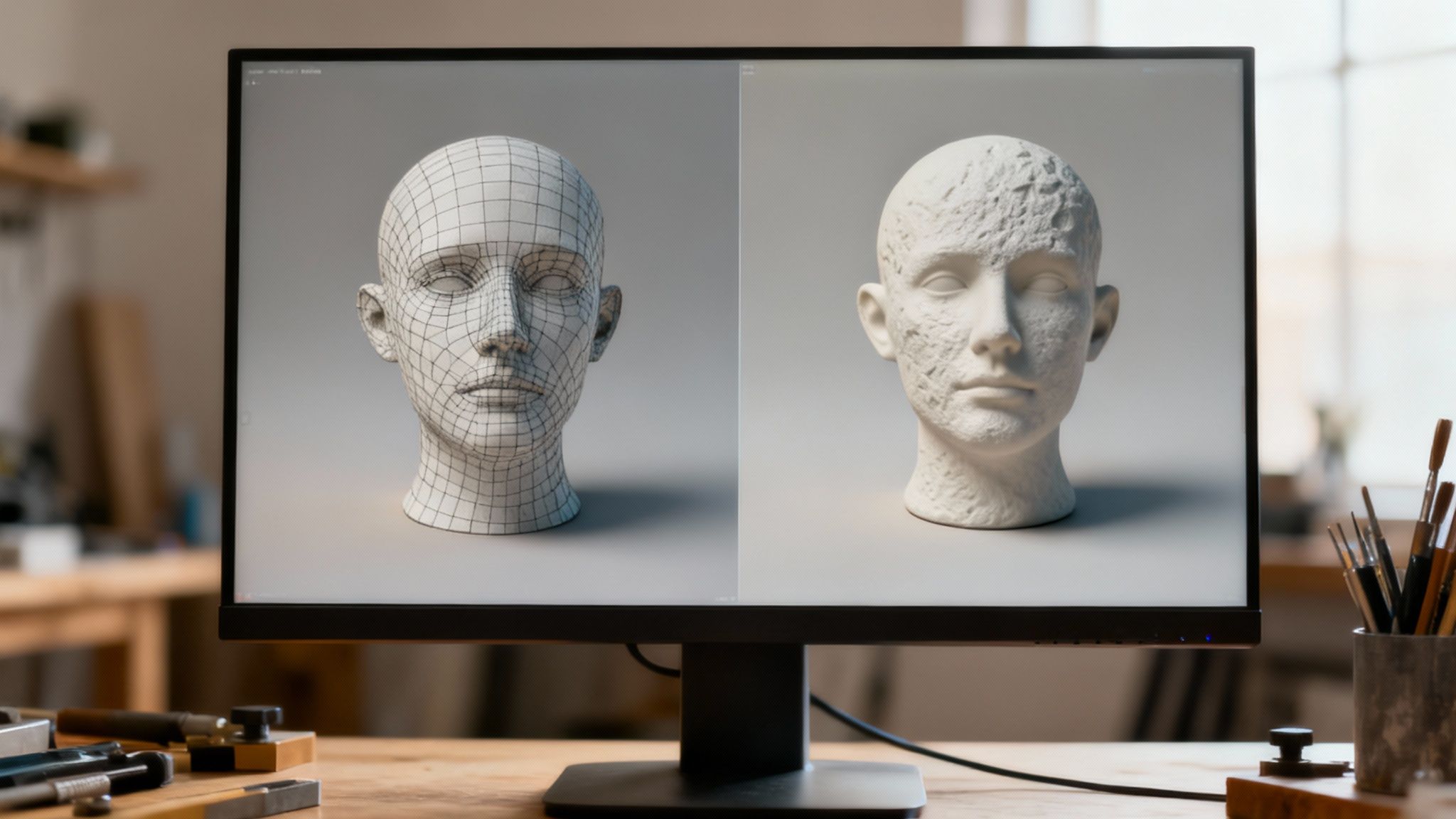
The initial AI generation provides an excellent starting point, but true professional quality is achieved in the refinement stage. This is where you transform a promising draft into a polished, project-ready asset.
It is realistic to expect minor imperfections in the first generated model; this is a natural part of any automated process. You might identify minor texture artifacts, slightly uneven surfaces, or a mesh that could be optimized. Addressing these details is what distinguishes a good result from a professional one.
Consider the AI's output as high-quality clay; your role is to sculpt and perfect it.
Tidying Up Your 3D Mesh
Your first step should always be a detailed inspection of the model's geometry, or mesh. The mesh is the polygonal framework that defines the object's shape. AI-generated meshes can sometimes be less than optimal—either overly dense or containing irregularities.
Cleaning up the mesh involves two main objectives:
- Correcting Imperfections: Identify and address any anomalous bumps, holes, or floating polygons. These can typically be smoothed or removed using basic sculpting tools in software such as Blender.
- Optimising Polygon Count: This is where retopology becomes relevant. It is the process of reconstructing the mesh with a more logical and efficient polygon flow. A clean topology makes the model easier to work with, animate, and perform better in real-time engines.
A clean, optimized mesh is the foundation for all subsequent work.
Pro Tip: Do not expect a perfect mesh directly from the AI. The initial output is best utilized as a high-fidelity reference. Your task is to preserve the overall form while simplifying the underlying geometry for better performance and easier texturing.
Enhancing Surface Details and Textures
Once the mesh is in order, the focus shifts to the surface. While the AI does an impressive job creating textures from the source image, they can always be enhanced to add an extra layer of realism.
Begin by inspecting the texture for any blurry or stretched areas. This can occur when the AI has difficulty mapping the 2D image perfectly onto the 3D shape. These issues can often be corrected in an image editor or using texture painting tools within your 3D software.
For even more convincing detail, you can learn how to make a normal map. This is an effective technique for adding fine surface details like bumps and grooves without increasing the model's polygon count.
This focus on computational efficiency is not just a commercial goal. The drive to convert 2d image to 3d model assets more effectively is also a significant topic in academic research in Denmark. For instance, institutions like the Technical University of Denmark (DTU) are developing new algorithms to approximate complex 3D shape metrics from 2D images, which could drastically accelerate quality control in manufacturing. You can explore how Danish research is reducing computational costs in 2D-to-3D conversion on arxiv.org.
Getting Your Model into the Real World
You’ve refined and polished your AI-generated model. However, a 3D asset is only useful if it can be integrated into your game engine, architectural software, or 3D printer. The final step involves exporting it in a format compatible with your creative pipeline.
Choosing the correct file format is crucial for interoperability. Different industries have their own standards, and selecting the wrong one can result in data loss or import errors. Your decision should be based on the model's intended destination.
For example, a game developer will prioritize performance and animation support. An architectural visualization specialist, conversely, needs to preserve high-fidelity material data.
Picking the Right File Format
Think of file formats as different containers, each designed for a specific purpose. Some are general-purpose, while others are optimized for modern web applications. Familiarity with the main options is key.
Here are the most common formats you will encounter:
- .OBJ: This is a long-standing and reliable format. It is widely supported and dependably stores geometry and basic texture information (UVs). It is ideal for static models but lacks support for animations or complex materials.
- .FBX: Developed by Autodesk, FBX is the industry standard for animation and game development. It can package geometry, materials, textures, and animation data into a single file, making it the preferred choice for pipelines involving tools like Unreal Engine or Unity.
- .GLTF/.GLB: Often referred to as the "JPEG of 3D," this modern format is optimized for web and AR applications. It is lightweight, loads quickly, and supports PBR (Physically Based Rendering) materials, which is essential for realistic visuals on platforms like Sketchfab or in VR.
There is no single "best" format—each project has unique requirements. The goal is to match the file type to your final destination, ensuring that all your work is preserved during transfer to another application.
For a more in-depth exploration of this topic, please see our detailed guide on 3D model file formats.
Tweaking Your Export Settings
Beyond the file type, a few final settings can significantly impact the outcome. Pay attention to texture compression, which reduces file size without drastically compromising visual quality—a critical consideration for any real-time application. Also, verify that your model's scale is set correctly to avoid importing a microscopic object into your main project scene.
Addressing these details ensures your asset is truly pipeline-ready, successfully completing the journey to convert a 2D image to a 3D model.
Got Questions About 2D to 3D? We Have Answers
As you begin turning flat images into 3D assets, certain questions frequently arise. Understanding the nuances of AI conversion helps set realistic expectations and provides a framework for troubleshooting. Let's address some of the most common inquiries.
What Makes a "Good" Image for AI Conversion?
A frequently asked question concerns the ideal type of image for conversion. The answer is almost always a single object against a clean, simple background, similar to a classic product photograph on a white or grey backdrop.
This clarity is highly beneficial for the AI. It allows the system to easily distinguish the subject from its surroundings, which is the most critical first step in constructing a clean 3D mesh.
Conversely, images with busy backgrounds, multiple overlapping objects, or dramatic shadows tend to present challenges. The AI might interpret a dark shadow as part of the object’s physical shape, leading to artifacts, holes, or distorted geometry in the final model.
Can the AI Handle Any Type of Image?
While the technology is advanced, it has its limitations. The AI performs best with photographs of distinct, solid objects—such as sculptures, footwear, furniture, or produce. It excels at analyzing the shape and volume from a single photo to create a plausible 3D version.
However, certain subjects are inherently difficult for it to process.
Transparent or highly reflective objects, like a wine glass or a chrome faucet, often confuse the AI. Their surfaces interact with light in complex ways, providing little clean data for analysis. Similarly, very thin or fine objects—such as plant leaves, fabric threads, or hair—are often too delicate for the AI to reconstruct accurately from a single image.
The key is to select subjects with a clear, solid form. If you can easily trace the object's silhouette, it is likely that the AI can also "see" it properly. This is how you achieve a high-quality result when you convert the 2D image to a 3D model.
How Realistic Will My Textures Be?
Texture quality is another major consideration. The AI generates textures by projecting the pixels from your source photo onto the newly created 3D model. Consequently, the final texture quality is limited by the quality of the initial photograph.
For sharp, realistic textures, you must start with a high-resolution image. If your photo is blurry or low-quality, the 3D model will have a pixelated or indistinct texture.
Even lighting is equally important. If your photo has a harsh shadow on one side, that shadow will be "baked" into the texture. The model will then appear unnatural when placed in a new 3D scene with different lighting conditions. For optimal results, always begin with an image that is evenly lit and clear.
Ready to move from theory to practice? Virtuall is an all-in-one AI workspace for generating, managing, and collaborating on your 3D models, images, and videos. Start creating faster at Virtuall.pro.

